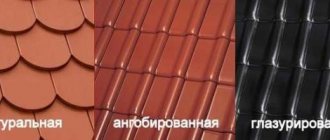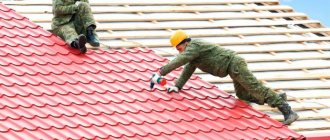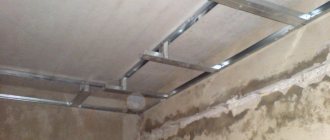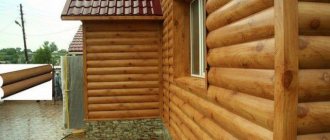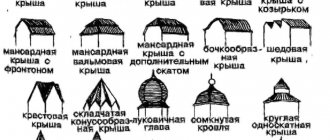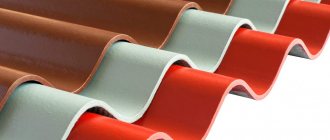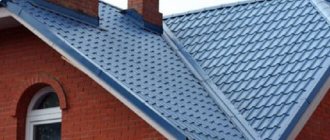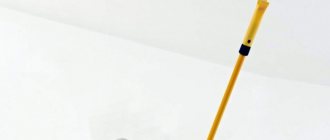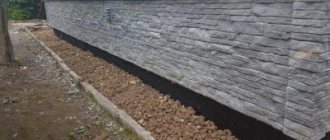Which roof is more popular?
Today, the building materials market is very rich and is represented by a large assortment of roofing materials.
The most popular roofing materials today are:
- Metal tiles,
- Flexible tiles or soft roofing (roofing ruflex, tegola, or a domestic product - roofing technonikol).
- Euroslate or ondulin
- Natural (ceramic) tiles
- Corrugated sheet
- Seam roofing
This is largely due to:
- quality characteristics of roofing materials,
- accessibility,
- the need to possess certain skills for independent installation of a seam roof.
note
Soft roofing or metal tiles are universal roofing materials that are applicable in various geographical areas. The installation and operation of such roofing materials are very simple and do not require any special, complex measures.
Advantages and disadvantages of metal roofing
Metal tiles are steel sheets with a wavy profile that externally imitate natural tiles. The reverse side is treated with protective varnish, the front side is treated with polymer film. Estimated service life is 50 years, warranty is 10-15. The permissible roof slope is from 12 degrees.
Advantages:
- strength;
- corrosion resistance;
- large sheet area speeds up installation;
- light weight, no increased load on the rafter system;
- Fire safety;
- the profile shape promotes good ventilation of the under-roof space;
- aesthetics, many colors.
Flaws:
- rigid profile sheets are not suitable for covering curved roofs and roofs with a circular cross-section;
- a large percentage of waste (up to 30%), especially when covering broken roofs;
- Difficulty of processing: only cold cutting with metal tools. You cannot grind the grinder so as not to damage the polymer shell;
- scratches formed during installation must be immediately painted over with polymer paint to avoid corrosion;
- poor sound insulation: metal is a sound conductor;
- thermal conductivity;
- electrical conductivity: a lightning rod is required.
Read more about installing metal roofing on this page.
- How I made a roof of complex shape in winter at the Snegiri CP
- 260 m2 - for 1,300 thousand rubles.
- See 28 photosMy prices
Classification of pitched roofs
A slope is a roof plane installed with a slope. According to the number and location of inclined parts, there are varieties:
Single-pitch
The roof plane has a one-sided slope with an angle of up to 30°, along which drainage is carried out. This type is used to cover small buildings or outbuildings. The advantage of coatings is their high resistance to wind loads, the disadvantage is that snow accumulates on the surface and water does not drain well.
Project of a house with a pitched roof
Gable
In such structures, the rectangular roof planes are directed in opposite directions at inclination angles of 20-42°. Snow and water do not linger on the surfaces. With a greater slope, the windage of the roof increases, which can lead to its tearing off during strong gusts of wind.
The gable roof easily copes with precipitation
They are called hipped. One pediment - the triangular part of the facade - is completely or partially replaced with a slope - a hip. The shape is more resistant to wind loads than the gable shape. Its varieties are half-hip Dutch with a shortened hip and hipped, where the slopes in the form of triangles are located at one angle, connecting at the top point.
Hip roof suitable for windy areas
Multi-pincer
The complex design combines three or more gable forms that cover houses with extensions and highlight an attic area with windows. The gables - pediments - are located parallel and perpendicular to each other. A spectacular roof is labor-intensive to construct, requires greater consumption of materials, and careful execution of joints.
A multi-gable roof looks most impressive. On our website you can find contacts of construction companies that offer roof repair and design services. You can communicate directly with representatives by visiting the “Low-Rise Country” exhibition of houses.
Attic
The space under the roof is used for housing or economic purposes.
Mansard roof will provide additional living space
Conical, dome or bell-shaped
Roofs of this configuration cover buildings that are round in plan. Due to the high cost of construction, they are found mainly in elite mansions, religious buildings and stylized buildings.
Conical roofing is beautiful, but not very practical
Pyramidal or spire-shaped
They are used for regular polygonal buildings and have an elongated shape. They decorate the building more than protect it from precipitation.
Advantages and disadvantages of soft roofing
Soft roofing (shingles, flexible tiles) is a material consisting of a fabric base (fiberglass, fiberglass, polyester), bitumen impregnation and granulated stone chips as an external covering. Some brands (in particular, French Icopal tiles) use copper foil instead of mineral granules. The tile backing is often self-adhesive, less often covered with silicon sand.
Note!
The average service life of a soft roof is 50 years, the warranty is from 10 to 50. The permissible angle of roof inclination is from 11 to 90 degrees.
There are models that can be laid at a lower slope, and there are also those that can cover negative areas. Pros:
- light weight, easy installation;
- when installed in warm weather, the tiles melt slightly under the sun, sinter and form a sealed continuous coating;
- the ability to design any pitched roofs, including domed, conical, curved;
- minimum waste during installation (within 5%);
- noiselessness, good thermal insulation;
- aesthetics, many colors, there are models with 3D effect. Many shingle shapes: hexagon, rectangle, beavertail, etc.
Minuses:
- due to its absolute tightness and flat shape, shingles place increased demands on the ventilation of the under-roof space;
- Although the material itself is comparable in price to metal tiles, in the end the roofing is more expensive due to the additional costs of underlayment and roofing cake with a complex structure.
Read about the cost of installing soft tiles in this material.
Types of roofing for different types of roof
The parameters of the rafter system have a significant impact on the choice of roofing; there are several factors that must be taken into account; this is the only way to guarantee a high-quality and durable roofing for the house.
Flat roofs
The angle of inclination of the slopes is no more than 12°. Such roofs are used during the construction of large country cottages; they can be used or ordinary.
Flat metal roofing
On the exploited flat roofs there are winter gardens, areas for active recreation or walking.
Flat roof and pool
There are options for arranging car parks on flat roofs. To create usable flat roofs, you should buy the most durable and reliable roll coverings or mastics. Currently it is a polyester-based euroroofing material.
Euroroofing material
This material has the highest strength indicators and a service life of at least fifty years. Modified bitumen is used as waterproofing, which does not lose its plasticity at low temperatures. On polyester roofs you can install heavy structures, make durable reinforced concrete screeds, etc.
Laying euroroofing felt
The second material for sealing flat roofs is liquid mastics. There is a wide choice in sales; in terms of their technical characteristics, mastics fully meet existing requirements.
Mastic roofing
Pitched roofs
The number of slopes is from one to 5–8, it all depends on the complexity of the rafter system and the architectural features of the structure. On pitched roofs, you can use any type of roofing materials: soft and hard, rolled and piece, profiled and flat, modern and traditional.
Multi-pitched tile roof
Each type has its own characteristics and is selected taking into account operating conditions, the selected design project and the financial capabilities of the consumer. The cost of some types of roofing can be very significant, and most developers cannot afford them.
Roof of complex configuration
Advantages and disadvantages of ondulin roofing
Ondulin (Euro slate) is similar in composition to soft tiles: cellulose-fabric base, bitumen impregnation, basalt chips. Unlike shinglas, ondulin is rigid sheets of profile shape. Service life is about 20 years. The permissible roof slope is from 6 degrees.
Pros:
- lightness (a sheet of 1 by 2 meters weighs on average 6.5 kg);
- water resistance;
- like shinglas, ondulin sheets are glued together under the sun;
- simple processing (can be cut with a regular hacksaw);
- simple installation;
- resistance to rotting and corrosion;
- high chemical resistance;
- the price is lower than that of metal tiles and shingles;
- noiselessness.
Minuses:
- In hot weather, you should not walk on the roof: the softened coating may become deformed. It will no longer be possible to restore the profile shape;
- flammability;
- discoloration. The rate of color loss depends on the brand;
- poor resistance to biological factors - vegetation, fungus.
I wrote more about the advantages and disadvantages of an ondulin roof in this article.
The best soft materials for roofing
Soft roofing materials are produced in the form of rolls, sheets or piece elements. Depending on this, a solid wooden or concrete base will be required. The exception is ondulin, which is nailed to the sheathing at an angle, like regular slate. Due to the soft structure, such a roof is quiet and perfectly protects the building from precipitation. But the surface strength is significantly inferior to the categories described above. But thanks to its flexibility, the material can be easily cut and bent on roofs of complex shapes.
Ondulin
Rating: 5.0
Ondulin is made from bitumen, where cellulose fibers act as a reinforcing base. Pigment additives are used to give brown or green color. The building material is produced in sheets up to 3.6 m long and weighing 6.5 kg. If installation is planned on an almost horizontal roof with a slope angle of 6 degrees, then a solid base will be required. With a sloping roof, lathing with a pitch of 45 cm is acceptable. In reviews, craftsmen praise the material for its flexibility and lightness. It is quite possible to lay it alone. If the canvas accidentally falls out of your hands, it will not break when colliding with the ground. But in hot weather, buyers are advised not to walk on such a roof, since ondulin softens greatly.
The material stands out for its noiselessness. Soft wave-shaped sheets perfectly dampen vibrations from strong winds and the impact of raindrops. Bitumen sheets reliably protect the roof from leaks and are designed for up to 30 years. If you want to enjoy peace and dryness in a private home, then this is the best option among soft materials. It is great for complex shaped roofs as bending it into place is easy.
Advantages
- can be laid at a slope of 6 degrees;
- excellent sound insulation;
- resists moisture well;
- a light weight;
- affordable price.
Flaws
- Over time, the color fades in the sun;
- after heating to 110 degrees it may catch fire;
- susceptible to moss germination;
- a large stone can pierce a leaf.
Ruberoid
Rating: 4.9
Varieties of roofing felt are called glass insulation or waterproofing. It is used for waterproofing the basement or roof. In the case of roofing, the material is laid on a concrete or wooden base. The tilt angle is allowed from 11 degrees. Polyester or fiberglass is used as a base. It is coated on both sides with oxidized bitumen, and the outer part is sprinkled with sand or crushed shale to give mechanical strength and protection from UV rays. The material is supplied in rolls, and to keep it flexible, modifiers are added to it. The roof turns out to be black and can be of complex shape, since the elastic canvas fits all corners well. For tightness, an overlap of 10 cm is required. This is the best option for creating the top layer of the roof of multi-storey buildings or garages with slab floors.
Experts praised the material for its speed of installation. Thanks to the length of the strip in a roll of 15 m and a width of 1 m, it is possible to cover 15 m² at once. In the case of a large flat roof, this significantly speeds up the work. There is no need to nail anything, since the material is fixed to its own sticky base, heated by a gas burner.
Advantages
- affordable price per square meter;
- easy to transport;
- service life up to 50 years;
- increases sound insulation;
- light weight.
Flaws
- subject to mechanical damage;
- for the flooring you need a gas burner and a cylinder, raised to the roof.
Bituminous shingles
Rating: 4.8
The structure of bituminous shingles is very similar to roofing felt. Here, too, the fiberglass base is treated with bitumen and sprinkled with stone chips. The difference is in the form factor. The material is produced not in rolls, but in strips of complex shapes. One edge is smooth and is intended for overlap, and the other is figured, imitating the edges of the tiles. It is located outside and can have a square, rectangular, trapezoidal or semicircular shape. When assembling the top layer of the roof, the sheet turns out to be like scales, only not as voluminous compared to ceramic tiles. The strips are mounted on a solid base and fixed using bitumen and polymer adhesive on the back side. The thick elastic part acts as an excellent insulator for sounds and cold. Craftsmen recommend materials for roofs of complex shapes, since the strips bend easily and are connected hermetically.
Soft roofing is noted by experts as the best in beauty in the category. The painted outer edges and dark inserts in the middle create an interesting color combination. From a distance, the drawing looks more voluminous than it actually is.
Advantages
- variety of form factors;
- easy installation in strips;
- stacks with almost no waste;
- serves as a heat and sound insulator;
- repels ultraviolet rays well due to stone chips.
Flaws
- you will need a solid base.
Advantages and disadvantages of ceramic roofing
Natural tiles are made from clay using high-temperature firing technology (1000º). Service life - up to 150 years, warranty - 30. Roof slope from 30º (for some models from 22).
Pros:
- aesthetics, respectable appearance;
- strength;
- good noise/heat insulation;
- water resistance, chemical resistance;
- temperature resistance;
- color fastness: does not fade even over time;
- Fire safety;
- high maintainability.
Minuses:
- the heaviest weight among all coatings, increased load on supporting structures;
- highest price.
When installing, pay attention to the quality of the tiles: if there is a crack, the tile will break if water gets in and freezes.
See our work on installation of roofs made of natural tiles in the “our work” category.
The best piece materials for roofing
Piece roofing materials are small segments connected to each other to form a sheet. The surface is stepped, so a slope is required for water drainage. As a base, you will need a transverse lathing in increments of 10-30 cm, depending on the length of the tiles. Installation is quite lengthy, since the roof needs to be assembled from many small elements, but the service life and strength of the surface are among the best.
Ceramic tiles
Rating: 5.0
This roofing material is made from molded clay. Tiles with a wavy surface, like scales, are available in sizes 330x420 or 240x390 mm and can weigh up to 4.5 kg each. Then they are fired in high-temperature ovens, after which the product gets a beautiful appearance and improves its strength. Reviews show that such a roof tolerates precipitation and any mechanical damage well. Ceramic roofing does not burn and does not deform from high or low temperatures. Thanks to its thickness and density, it perfectly protects the building from cold or heat. Such a roof also serves as a good sound insulator. But installation will require frequent lathing and powerful rafters, otherwise the roof will not support the heavy weight and will collapse under its own weight.
This material is considered the best in terms of service life and strength. If installed correctly, it will withstand any hail, impacts from branches and stones, not to mention the weight of a person. Manufacturers indicate a guaranteed service life of tiles of 20-50 years, but in practice there are houses with ceramic roofs that have been standing for 150 years or more. This is an option for a cottage or a good-quality private house.
Advantages
- high fire resistance;
- does not deform from high or low temperatures;
- variety of form factors;
- well insulates the building from heat and cold;
- beautiful appearance.
Flaws
- heavy weight;
- you need lathing with fine pitch;
- only for roofs with a slope angle of 22-60º;
- long installation;
- high price.
Cement-sand tiles
Rating: 4.9
In appearance, the material resembles ceramic tiles, but is made from a mixture of cement and sand. Another significant difference in production is that corrugated tiles are not fired in a kiln, but are pressed under high pressure, which makes them durable. Pigment additives are added to the solution, so in appearance it is very similar to fire-fired ceramics. The roof is installed in a similar way - lathing is placed on the rafters to a material size of 420x330 mm. Fastening is carried out with nails or self-tapping screws into pre-drilled holes, as well as with clamps. There are models with special locks that increase the tightness of the canvas. The roof inclination angle is permissible 20-60 degrees.
The main advantage of the material is its reduced weight, with a completely identical appearance to ceramic tiles. If in the latter one square meter weighs up to 75 kg, then here the weight of 1 m² is 40-45 kg. Therefore, the rafter system will be subject to less load and you can save on the cross-section of the tree. The material will last up to 100 years. We recommend using it on the roofs of private houses.
Advantages
- beautiful view;
- variety of form factors;
- long service life;
- does not support combustion;
- good sound insulator.
Flaws
- you need lathing with fine pitch;
- breaks easily during careless transportation;
- the cost is also high.
Slate tiles
Rating: 4.8
The review continues with slate tiles. It is a natural material obtained by natural formation in the depths of the earth under pressure and temperature. It is mined in mines or by opencast mining. The rock is processed to sizes of 150x200 or 300x600 mm. The natural black color of the stone looks exclusive and primitive. Roofs made of this material are very popular in Europe, but in Russia this tile is already beginning to be in demand in the construction of cottage roofs. Stone tiles can be laid on a slope of 25º. Fixation is carried out using nails. The rich black color does not fade under the influence of ultraviolet radiation, and the material itself does not burn and is frost-resistant. Thanks to their smooth surface, the tiles press tightly against each other and form an airtight membrane.
Experts praise the material for its long service life of 200 years. Another advantage is the thickness of the tiles. If the cement-sand analogue has a cross-section of 10 mm, and the ceramic versions have a cross-section of 5 mm, then slate tiles have a cross-section of 4 mm. This helps reduce weight and roof load. But not everyone can afford the high cost, which is why the material takes third place on the list.
Advantages
- unusual primitive appearance;
- thin section 4 mm;
- does not fade;
- huge service life;
- the material is suitable for surfaces of complex shapes.
Flaws
- long installation;
- high price.
Composite tiles
Rating: 4.7
This material consists of sheets of steel coated with zinc to resist moisture. Mineral powder made from quartz or basalt chips is used as a decorative finish. Thanks to this, the material looks like natural tiles. It is produced not in one wavy plate, but in strips with one row, where there can be six waves. This requires the same frequent lathing, but installation is much faster, since one segment covers 0.4 m² at once. Manufacturers assure that the service life of the material is 50 years. Due to the metal base, it tolerates mechanical loads well, and the stone powder increases heat and sound insulation. In terms of weight, the material significantly outperforms opponents in the category, because the mass of 1 m² reaches 6 kg. In reviews, buyers note that due to the rough surface there is no need for snow barriers on the roof.
If you want a tile roof, but are not willing to pay for ceramics or a sand-cement mixture, then a composite material will be the most optimal. It looks almost identical to these two analogues, but costs 2-4 times less. Use the product to create the roof of a private house, store or low-rise office building.
Advantages
- service life up to 50 years;
- provides additional sound and heat insulation;
- variety of colors;
- high fire safety;
- imitates the look of natural tiles.
Flaws
- the roof becomes contaminated with dust faster.
Advantages and disadvantages of corrugated roofing
Corrugated sheeting – profiled galvanized steel with or without polymer coating. In its basic properties, corrugated sheets are similar to metal tiles, but are somewhat inferior to them in aesthetic terms. Service life is about 30 years. The slope of the roof is any, depending on the height of the profile and the pitch of the sheathing.
Pros:
- simple installation;
- Fire safety;
- light weight;
- water resistance;
- corrosion resistance due to a layer of zinc and polymer coating;
- versatility: sheets of the same color can be used for roofing, fencing, facade cladding of garages and other technical buildings;
- sheets with the highest profile can be used as a base for flat unused roofs;
- The price is comparable only to ondulin, everything else is more expensive.
Minuses:
- does not bend, not suitable for curved roofs;
- complexity of the cut (only canvas or metal scissors);
- high percentage of waste;
- conducts sound, heat, electricity.
Advantages and disadvantages of seam roofing
Seam roofing is flat sheets or metal in rolls. Separate blanks (pictures) are connected to each other by folds. Additionally, the folds serve as stiffening ribs. Service life depends on the material: galvanized steel - 30 years, aluminum - 80, copper and zinc-titanium - 100. Roof slope - from 7º.
Pros:
- with high-quality installation, the seam fastening is sealed and eliminates leaks;
- flexible sheets allow installation on curved roofs;
- if you have the tools – simple and quick installation;
- minimum waste.
Minuses:
- poor sound/thermal insulation;
- good electrical conductivity, lightning protection is required.
I wrote more about the nuances of installing a seam roof here.
Which roof is better?
When choosing a roofing material, you should follow the advice of professionals. If we talk about service life, then soft roofing and metal roofing will last you 20-30 years. Manufacturers guarantee that this period will be 30 years, or even more. But, in my experience, it depends on many factors. And first of all, it depends on the climatic conditions of your region.
As for the appearance, then, as they say, the taste and color... Both materials on the market are presented in a variety of colors and you will have the opportunity to choose the most suitable one.
An equally important issue when choosing a material for roofing is the issue of performance characteristics. A huge advantage, in my opinion, in this matter is noiselessness. This is especially felt on a roof covered with a soft roof. And as my experience shows, many people choose this material based on this characteristic.
Pitched roof installation
The rafter system is the supporting frame of the roof. It consists of elements:
- Mauerlat - beams on which the entire structure rests. It is mounted along the perimeter of the walls in the upper part.
- Rafter legs - inclined elements placed in increments of up to 1 m and connected to each other by horizontal purlins. They can be hanging or layered depending on the type of support.
- Ridge - The top of the roof, the horizontal beam to which the rafters are attached.
- Lathing or decking is a supporting structure for the “roofing cake”, adding stability to the rafter system.
- Roofs - an external covering consisting of layers of insulation, hydro- and vapor barriers, wind protection, and roofing material.
- Racks, struts, crossbars - vertical, horizontal and diagonal connections that give the frame rigidity and stability.
- Valleys, valleys - connecting elements at the intersections of roof planes.
- Overhangs are extensions of slopes beyond the outer walls.
Diagram of a gable roof This may be interesting!
In the article at the following link, read about metal roofing.
The rafter system for private construction is usually made of wood. The material is accessible and easy to process. It is lightweight and quite durable. You can create any spatial frame without making the system heavier.
Roofing materials are varied. To choose which roof is best for a private home, you need to know the features of their application.
Our works
Reconstruction of the roof in Pozdnyakovo
Replacement of roofing in Dzerzhinsky
Roof installation in EKP "Monolith"
Reconstruction of the roof in Gorodishche
Roofing materials prices
If we talk about the cost of these materials, then for soft roofing and metal roofing the price is approximately the same and ranges from 200 r m2 to 500 m2.
This is the cost for the material, but please note that in the end, a roof made of soft tiles will cost slightly more, due to the fact that installation requires a more complex roofing pie.
note
We have already discussed in more detail which roofing is cheaper in this article. We compared the costs of materials and installation of roofing made from metal tiles, corrugated sheets, flexible tiles, roofing felt, ondulin and slate. You can see the calculations here.
What types of roofs are made on a house?
There are several types of roofing used for the roofs of private houses. To decide which roof is best for a given building, you need to decide on your priorities.
For example, one owner needs maximum space in the attic floor, while another would prefer to save on materials and work. The decision of which roof to choose is also influenced by the size and purpose of the building.
The most common roofs of private houses are one of the following types.
Single-pitch
The simplest and most inexpensive roofing option. It consists of a single slope located at an angle to the horizon to facilitate the drainage of rain and melt water, as well as snow removal. The front and rear walls of the building have different heights, and the side walls have a bevel along the top edge.
Advantages:
- simplicity of design and installation;
- cheapness;
- resistance to wind load.
Flaws:
- the difficulty of using the attic space due to its low height;
- inapplicability for large buildings;
- high snow load and weak natural snow melting;
- unaesthetic appearance.
Such roofs are best used in regions with little snow, as well as for utility and domestic buildings. This is the most economical roofing for a one-story wooden house.
Gable
It consists of two symmetrical or asymmetrical slopes, usually located at equal angles to the horizon. The symmetrical design is highly durable; such a roof can accommodate an attic floor. It can be illuminated through ordinary windows in the gables or through dormer windows built into the plane of the slopes.
Advantages:
- strength: a symmetrical rafter system resists variable loads better than others and distributes them evenly across the walls;
- reliability: a single joint along the ridge ensures long service life;
- by increasing the angle of inclination, you can increase the ability to withstand snow loads and at the same time increase the volume of the attic space;
- ease of design and installation;
- reasonable price.
The disadvantages of gable systems include:
- the influence of the area of the house on the height of the roof and its angle of inclination;
- the need to install skylights to access the roof.
Such roofs are used for small and medium-sized private houses, bathhouses, and outbuildings.
Three-slope
This scheme is used, as a rule, for extensions, verandas and other adjacent elements of the building. This is part of a hip or hip roof, where the role of the fourth slope is played by the wall of the main building.
As an advantage, it should be noted that it ensures stylistic unity with the main building.
Disadvantages include:
- wasteful use of roofing materials;
- complexity of the truss structure
- increased accuracy during installation is required.
Broken
The slopes of a sloping roof consist of two planes joined at a certain angle. This design significantly increases the opportunity for more complete use of the roof space.
Advantages:
- increased resistance to snow and wind loads;
- high volume utilization rate;
- maximum added area;
- high ceilings in the attic rooms;
Flaws:
- design complexity;
- high consumption of materials;
- Difficulties with lighting the attic.
Most often they are used in rectangular residential buildings, as well as in domestic buildings. Which roof to choose if you need maximum space in the attic? Most likely a broken one.
hip
The hip, or “envelope” roof, consists of four slopes: two end, triangular, and two in the form of a trapezoid, joined at the ridge.
Advantages:
- high strength;
- resistance to wind and snow loads;
- small number of joints;
- good tightness;
- Possibility of installing attic floors.
The disadvantages of hip roofs include:
- complexity of the rafter system;
- exceptionally high precision during installation;
- the need for highly qualified workers;
- difficulty in roof maintenance.
When installing skylights, the strength of the structure is reduced, and the rafter system has to be strengthened. Which roof is best for a large, solid house? Probably hip.
A special case of a hip roof is a hip roof. It consists of four identical triangular slopes and is mounted on square buildings: houses, towers, gazebos.
So which roof should you choose?
I would choose a soft roof, because I believe that this is the material of the future, and it has a number of advantages over other roofing materials. Of course, it’s up to you to choose; my job is to give advice, professional advice.
If you are planning to build a roof for your home soon, I advise you to call me immediately. I will try to suggest which and how best to make a roof. I look forward to your requests, I’m glad to be of assistance.
If you have questions, ask directly in the form below.
+7(495) 241-00-59
Installation and repair of roofing and facade coverings from economy to VIP class
Calculate online
my experience is your saved money and nerves.
I advise everyone who contacts me, even if you later leave to join another brigade. Ask questions, don’t be shy, I answer everyone - it’s free
+7(495) 241-00-59 I am available for calls 7/24 - I will be happy to help you, please contact me!
Additional materials on the topic
Roof color selection
More details
Types of soft roofing
More details
Ondulin roof installation
More details
Your feedback, comments, questions
Dear visitors! We will periodically answer your questions in the comments as we are busy. In order for us to respond to you promptly (within an hour), you can: call, write a personal message or leave a request for a free consultation by phone.
Comments
Aristarkh V. 07/11/2012 17:03
0 could you write the ratio of prices and quality of roofing types and is there any point in overpaying?
Reply | Reply with quote | Quote Consultation by phone +7(495) 241-00-59 Answered by Mikhail-Foreman moderator
I previously wrote that the main quality of a roof is not to allow everything that falls on it into the house to pass through, and everything else is like tuning), so all calculations are based on the wallet
Alexey 04/23/2013 10:29
-1 Hello! How familiar are you with liquid roofing (Ukreplen, Hydrolon, Tenoprok, etc.)? If you have experience using it, what would you recommend? The roof is unusable, on top of reinforced concrete slabs covering an unheated room, the climate is moderate. Thank you.
Reply | Reply with quote | Quote Consultation by phone +7(495) 241-00-59 Answered by Mikhail moderator
I can’t give you any advice on these coatings.
Andrey 12/31/2013 04:46
-4 How long can a metal tile roof last if the air humidity in the region reaches 90 percent? In your opinion, is it worth covering the roof with metal tiles or is there another, more profitable option in this climate?
Reply | Reply with quote | Quote Consultation by phone +7(495) 241-00-59 Answered by Mikhail moderator
With proper installation, the entire manufacturer's warranty period, which depends on the coating of the material.
Leonid 01/08/2014 16:15
-2 My country house is covered with slate, I keep dreaming of changing it to something more modern and functional. I’ll probably still choose metal tiles for myself.
Reply | Reply with quote | Quote Consultation by phone +7(495) 241-00-59 Answered by Mikhail moderator
Metal tiles or corrugated sheets.
Oleg 01/08/2014 21:48
-5 And I am in favor of a soft roof, I think that if you have to do installation, it is easier to deal with, while it is silent during operation and durable, and the material from which it is made is more environmentally friendly.
Reply | Reply with quote | Quote
Oleg 01/18/2014 10:46
-5 I have a soft roof at my dacha. I like it better because it has good sound insulation, it holds back snow well in winter, and it looks more beautiful.
Reply | Reply with quote | Quote Consultation by phone +7(495) 241-00-59 Answered by Mikhail moderator
I can't argue with you.
Leonty Isakov 09.28.2014 14:46
-1 The most reliable and durable, of course, is a metal roof. But at the same time the most expensive. This disadvantage is more than offset by the fact that such a roof rarely requires repairs, and you can always get by with “little blood” - tighten or replace loose screws, seal an existing crack with bitumen, or, less often, replace an entire sheet. And yet the question is: if there are other types of roofing that are cheaper, maybe it doesn’t make sense to overpay? After all, nothing is eternal in the world anyway...
Reply | Reply with quote | Quote
Sergey 08.10.2015 19:59
+2 Good afternoon, the urgent question is which roof to get? The second floor is a monsard, I can’t decide between flexible tiles or composite ones, and now a new product has come out - modular tiles. Please help me make the right choice. Thank you in advance.
Reply | Reply with quote | Quote Consultation by phone +7(495) 241-00-59 Answered by Mikhail moderator
Hello, Sergey, I can’t tell you about the modular one. Maybe you're talking about dune metal tiles?? Whether flexible or composite, everything is simple. Choose what you like best. The main difference in price is that composite tiles are more expensive and the complexity of laying composite tiles. Good luck!
Mikhail 10.10.2015 09:51
+2 Hello, can you tell me what is not expensive (very meager supply of funds), but the optimal material for the roof, appearance is not important, the main thing is that it is practical?
Reply | Reply with quote | Quote Consultation by phone +7(495) 241-00-59 Answered by Mikhail moderator
In your case, the optimal material is corrugated or metal tiles. Ondulin is not a very good material, the only plus is that it is light!
Svetlana 07/26/2016 18:05
0 Lay out the profile. Slope 3%, area 130 m2. The man cheated - they didn’t follow. The room should be warm, but the profile lies directly on the boards. We think, rack our brains, how to fix the situation. Either remove this roof, insulate it, glue the sheets together slowly, or don’t touch the profile itself, but insulate it on top and make a soft roof. What is your advice?
Reply | Reply with quote | Quote Consultation by phone +7(495) 241-00-59 Answered by Mikhail the foreman moderator
I would not recommend gluing the sheets. It’s better to make it flexible, more reliable and ultimately cheaper.
Leo 08/28/2016 10:32
+2 Mikhail, can you give specific examples of comparisons based on price, durability and popularity from your practice? After all, metal is expensive now, and what is more profitable to do, taking into account the roofing pie and preparation for the coating? I want to know briefly and without water the optimal roofing material for a house with an area of 100 m2
Reply | Reply with quote | Quote Consultation by phone +7(495) 241-00-59 Answered by Mikhail moderator
Hello, the choice of roofing material depends on several factors. First of all, you need to decide on the material - metal, bitumen. If the choice is not obvious, and you don’t care what you use, then you need to look at material costs. If the roof has a complex shape, then bitumen shingles definitely have more advantages, both in price and installation. If the form is simple, then the metal has no equal in price. I advise you to take metal tiles at least 0.5 mm, and cover according to your financial capabilities. The only thing is that I don’t see the point in chasing brands like ruuki, takaota, etc.
englisTed 02/17/2018 09:18
+2 I'll try it in my spare time :)
Reply | Reply with quote | Quote
Update list of comments
